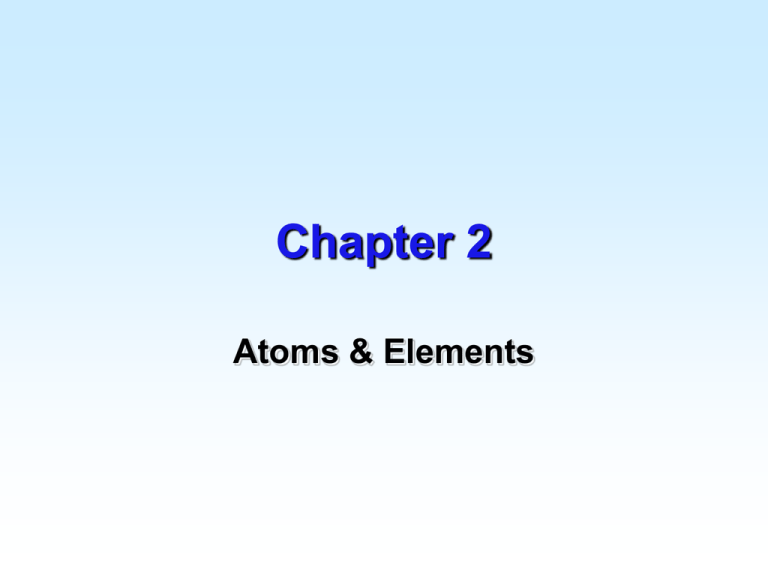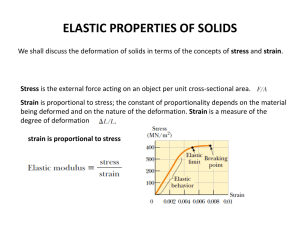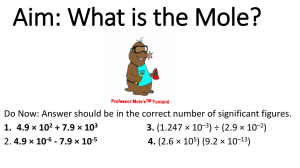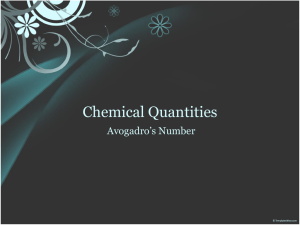Chapter-2 - UCF Chemistry
advertisement

Chapter 2 Atoms & Elements Dalton’s Atomic Theory (beginning of 19th century) • All matter is composed of tiny, indivisible particles called atoms • All atoms of a given element are identical to each other and different from those of other elements • A chemical reaction merely involves a change in the groupings of atoms and not creation or destruction of atoms (Law of Conservation of Mass) • Compounds consist of atoms of more than one element combined in particular ratios (Law of Constant Composition and Law of Multiple Proportions) Building up Atomic Structure • Benjamin Franklin (1706-1790) discovered two types of electricity, (+) and (-). • Henri Becquerel discovered radioactivity on 1896. Pierre and Marie Curie continued that work: atoms disintegrate, i.e., they are divisible. • John J. Thomson discovered the electron and determined its charge/mass ratio (1896-97). • Robert A. Millikan (1909) determined the charge and mass of electron. • Ernest Rutherford (1911-19) discovered the proton. • James Chadwick (1932) discovered the neutrons, that are with the protons in the nucleus of atoms. Atomic Structure • subatomic particles neutron: no charge, 1.0087 amu, n proton: +1 charge, 1.0073 amu, p+ electron: –1 charge, 0.0005486 amu, e– • n and p+ packed tightly into dense core called nucleus • e– distributed more diffusely in space surrounding nucleus e– n p+ e– Actual size: Radius of atom ~ 100 pm (10-10 m) Radius of nucleus ~ 0.001 pm Then, if radius of atom was ~ 100 m (a small football stadium), the radius of the nucleus would be ~ 0.001 m = 1 mm V r3 Then, Vatom/Vnucleus 1015. Atom is 1015 times bigger Atomic number and Mass number • all atoms of a given element have the same number of protons • number of protons in an atom given by the atomic number, Z • neutral atoms have same number of protons and electrons • atoms gain or lose charge by gaining or losing electrons only (not protons) • total number of protons and neutrons given by mass number, A. A = #p+ + #n Symbol mass number charge A X Z atomic number n element symbol Examples Determine the numbers of electrons, protons, and neutrons in each of the following atoms. 40 Ar 18 40 Ar 18 Z = 18, therefore the atom has 18 p+ A = 40, A = # of p+ + # of neutrons Therefore, # neutrons = A − # p+ 40 – 18 = 22 neutrons Charge, n = 0, therefore # of e– = # p+ = 18 209 2+ Pb 82 • Z = 82, therefore 82 p+ • A = 209, therefore 209 p+ and n total • # neutrons = A − # p+ = 209 – 82 = 127 n • n = 2+, • Therefore # e– = 82 p+ − 2 = 80 e– (lost 2 e–) 31 15 P 3– 31 3– P 15 Z = 15, therefore 15 p+ 31 3– P 15 Z = 15, therefore 15 p+ A = 31, therefore 31 p+ and n total 31 15 P 3– Z = 15, therefore 15 p+ A = 31, therefore 31 p+ and n total 31 – 15 = 16 n 31 3– P 15 Z = 15, therefore 15 p+ A = 31, therefore 31 p+ and n total 31 – 15 = 16 n n = 3 –, (gained 3 e–) Therefore, # e− = 15 + 3 = 18 e− Isotopes • atoms (of same element) that have the same number of protons but different numbers of neutrons, i.e., different A • may or may not have same number of electrons 52 24X 55 24X 52 24X 55 24X 52 24X 52 20X 52 X 24 55 52 X 24 52 X 20 24 X 52 3+ 50 24 24 X X Which of the pairs of atoms is(are) isotope(s)? Isotope abundance A sample of naturally occurring sulfur contains several isotopes with the following abundances Isotope % abundance 32S 95.02 33S 0.75 32S, 33S, 34S, 36S 34S 4.21 16 16 16 16 36S 0.02 The %s have been determined experimentally. # of atoms of a given isotope % Abundance = ──────────────────────────── x 100 Total # of atoms of all isotopes of element Mass Spectrometry is employed to determine Isotopic Abundances • mass spectrometer. – Device generates ions that pass down an evacuated path inside a magnet. – Ions are separated based on their charge/mass ratio. Mass is, then, calculated. Atomic Weight The atomic mass and Isotope Abundances are determined by means of Mass Spectrometry. Atomic mass of isotope carbon-12 is defined exactly 12 amu whereas all others of carbon and other elements are referred to that and do not have integer values. % abundance isotope 1 Atomic weight = x (mass isotope 1) 100 % abundance isotope 2 + x (mass isotope 2) + … 100 Example Isotope % abundance 64 Zn 48.6 66Zn 27.9 67Zn 4.1 68Zn 18.8 70Zn 0.6 mass (amu) 63.9291 65.9260 66.9721 67.9249 69.9253 Example, contd. %abund.i Atomic weight of Zn = ∑ mi 100 A.W.= 0.486 63.9291 + 0.279 65.9260 + … + 0.041 66.9721 + 0.188 67.9249 + … + 0.006 69.9253 = 65.4 amu # 25. Gallium has two naturally occurring isotopes, 69Ga and 71Ga, with masses of 68.9257 amu and 70.9249 amu, respectively. Calculate the % abundance of the two isotopes of Ga. A W Ga = 69.723 (Per. table) Let’s name p1 = % of 69Ga and p2 = % of 71Ga. p1 + p2 = 100 then, p1 = 100 − p2 (1) p1 68.9257 + p2 70.9249 AW = 69.723 = ──────────────────── then, 100 6972.3 = p168.9257 + p270.9249 Then, replace p1 by (1) 6972.3 = (100 − p2) 68.9257 + p2 70.9249 6972.3 = 6892.57 − p2 68.9257 + p2 70.9249 6972.3 − 6892.57 = p2 (70.9249 − 68.9257) 6972.3 − 6892.57 p2 = ─────────── = 39.88% 70.9249 − 68.9257 p1= 100 − p2 = 60.12% Atoms and the Mole A collection term states a specific number of items. • 1 dozen donuts = 12 donuts • 1 ream of paper = 500 sheets • 1 case = 24 cans Atoms and the Mole A mole is (a collection number) the amount of a substance that contains • the same number of particles (atoms, molecules, ions, protons, electrons, etc.) as there are carbon atoms in 12 g of carbon-12 isotope • 1 mol = 6.022 x 1023 particles (Avogadro’s number). Amadeo Avogadro • The number is referred to the atomic mass assigned to carbon-12 isotope. Atoms and the Mole 1 mole of … Number of particles 1 mole C = 6.022 x 1023 C atoms 1 mole Na = 6.022 x 1023 Na atoms 1 mole Au = 6.022 x 1023 Au atoms 1 mole electrons = 6.022 x 1023 electrons 1 mole H2O = 6.022 x 1023 H2O molecules 1 mole Na+ = 6.022 x 1023 Na+ ions Molar Mass The molar mass of any element is the mass in grams of 6.022 x 1023 atoms of that element, i.e., one mole of the element. Molar mass is abbreviated M, has units of grams per mole (g/mol), and is numerically equal to the atomic weight of the element (periodic table). Molar mass of Na = 22.990 g/mol Molar mass of Cl = 35.453 g/mol Molar mass of O = 15.999 g/mol Conversion factors Avogadro’s number 6.022 x 1023 can be written as equalities and conversion factors. Equality: 1 mole = 6.022 x 1023 particles = molar mass (g) Conversion Factors: particles = atoms or molecules 6.022 x 1023 particles and 1 mole 1 mole 6.022 x 1023 particles 6.022 x 1023 particles molar mass (g) 1 mole molar mass (g) and and molar mass (g) 6.022 x 1023 particles molar mass (g) 1 mole Converting moles ↔ mass Moles to mass g moles x ──── = grams 1 mol Mass to moles 1 mol g x ────= moles grams The molar mass as conversion factors What is the mass of silicon represented by 0.250 moles of this element? M of Si = 28.086 28.09 g g/mol 0.250 moles x ────── = 7.02 g Si 1 mol How many moles of manganese are 19.36 g of that metal? M of Mn = 54.938 g/mol 1 mol 19.36 g x ───── = 0.352384 = 0.3524 moles 54.938 g 4 SF How many atoms of calcium are in 4.008 g of that metal? M of Ca = 40.08 g/mol 1 mol 6.022 x 1023 atoms 4.008 g x ────── x ───────────── 40.08 g 1 mol = 6.022 x 1022 Ca atoms The density of Au is 19.32 g/cm3. What is the volume of a piece of gold that contains 2.6 x 1024 atoms? If the piece of metal is a square with a thickness of 0.10 cm, what is the length (in cm) of one side of the square? AW = 196.97 g/mol 196.97 g Au 2.6 x 1024 atoms Au x ──────────── = 850 g Au 6.022 x 1023 atoms 1 cm3 850 g Au x ──────── = 44 cm3 Au 19.32 g Au side = l V = th x A = th x l2 A = area = thickness (th) l2 l = SQRT (V/th) = SQRT (44 cm3 / 0.10 cm) = 21 cm What is the average mass of one germanium atom? M Ge = 72.59 g/mol Here we have to divide the mass of a mole by the number of atoms in that mole. 1 mole Ge = 72.59 g = 6.02 x 1023 atoms 72.59 g Ge 1 mol Ge g Ge ─────── x ───────────── = 1.205 x10-22 ───── 1 mol Ge 6.022 x1023 atoms Ge atom Ge 0.0000000000000000000001205 g !!!!!!! Periodic Table(*) • a listing of the elements arranged according to their chemical and physical properties • elements are arranged according to similar properties. • Groups or families contain elements with similar properties in vertical columns. • periods are horizontal rows of elements. Every period has a number (row) from 1 through 7. (*) originally Mendeleev by atomic mass (1869), later Moseley by increasing atomic number (1913). Periodic Table Groups • referred to by number or top element • some have names: The Representative Elements • alkali metals - group 1A • alkaline earth metals - group 2A • noble gases - group 8A • halogens - group 7A • chalcogens - group 6A • pnictogens - group 5A Alkali Metals Group 1A(1), the alkali metals, includes lithium, sodium, potassium, rubidium, cesium, and francium Halogens Group 7A(17) the halogens, includes fluorine, chlorine, bromine, and iodine. Representative Elements 1 1A 1 1 1.008 3 2 2A 4 Li Be H 13 3A 5 6.941 9.012 11 12 Na Mg 22. 99 19 24. 31 20 3 3B 21 K Ca Sc 39. 10 37 40. 08 38 44. 96 39 Rb Sr Y 85. 47 55 87. 62 56 88. 91 57 4 4B 22 5 5B 23 6 6B 24 7 7B 25 Ti V Cr Cr Mn 47. 88 50. 94 40 41 Zr Nb 91. 22 92. 91 72 73 52. 00 9854. 94 42 43 8 8B 26 9 8B 27 10 8B 28 Fe Co Ni 55. 85 44 58. 93 45 58. 69 46 11 1B 29 12 2B 30 Cu Zn 63. 55 65. 39 47 48 14 4A 6 15 5A 7 16 6A 8 17 7A 9 18 8A 2 He 4.003 10 B C N O F Ne 10. 81 13 12. 01 14 14. 01 15 16. 00 16 19. 00 17 20. 18 18 Al Si P S Cl Ar 26. 98 31 28. 09 32 30. 97 33 32. 07 34 35. 45 35 39. 95 36 Ga Ge As Se Br Kr 69. 72 49 72. 59 50 74. 92 51 78. 96 52 79. 90 53 83. 80 54 Mo Tc Ru Rh Pd Ag Cd In Sn Sb Te I Xe 95. 94 74 (98) 75 101.1 76 102.9 77 106.4 78 107.9 79 112.4 80 114.8 81 118.7 82 121.8 83 127.6 84 126.9 85 131.3 86 Cs Ba La Hf Ta W Re Os Ir Pt Au Hg Tl Pb Bi Po At Rn 132.9 87 137.3 88 138.9 89 178.5 104 180.9 105 183.8 106 186.2 107 Uns (262) 190.2 108 Uno (265) 192.2 109 Une (266) 195.1 197.0 200.6 204.4 207.2 209.0 (210) (210) (222) 71 Fr Ra Ac Unq Unp Unh (223) (226) (227) (257) (260) (263) 58 59 60 61 62 63 64 65 66 67 68 69 70 Ce Pr Nd Pm Sm Eu Gd Tb Dy Ho Er Tm Yb Lu 140.1 90 140.9 91 144.2 92 (147) 93 150.4 94 152.0 95 157.3 96 158.9 97 162.5 98 164.9 99 167.3 100 168.9 101 173.0 102 175.0 103 Th Pa U Np Pu Am Cm Bk Cf Es Fm Md No Lw 232.0 (231) 238.0 (237) (242) (243) (247) (247) (249) (254) (253) (256) (254) (257) Transition Elements 1 1A 1 1 1.008 3 2 2A 4 Li Be H 13 3A 5 6.941 9.012 11 12 Na Mg 22. 99 19 24. 31 20 3 3B 21 K Ca Sc 39. 10 37 40. 08 38 44. 96 39 Rb Sr Y 85. 47 55 87. 62 56 88. 91 57 4 4B 22 5 5B 23 6 6B 24 7 7B 25 Ti V Cr Cr Mn 47. 88 50. 94 40 41 Zr Nb 91. 22 92. 91 72 73 52. 00 9854. 94 42 43 8 8B 26 9 8B 27 10 8B 28 Fe Co Ni 55. 85 44 58. 93 45 58. 69 46 11 1B 29 12 2B 30 Cu Zn 63. 55 65. 39 47 48 14 4A 6 15 5A 7 16 6A 8 17 7A 9 18 8A 2 He 4.003 10 B C N O F Ne 10. 81 13 12. 01 14 14. 01 15 16. 00 16 19. 00 17 20. 18 18 Al Si P S Cl Ar 26. 98 31 28. 09 32 30. 97 33 32. 07 34 35. 45 35 39. 95 36 Ga Ge As Se Br Kr 69. 72 49 72. 59 50 74. 92 51 78. 96 52 79. 90 53 83. 80 54 Mo Tc Ru Rh Pd Ag Cd In Sn Sb Te I Xe 95. 94 74 (98) 75 101.1 76 102.9 77 106.4 78 107.9 79 112.4 80 114.8 81 118.7 82 121.8 83 127.6 84 126.9 85 131.3 86 Cs Ba La Hf Ta W Re Os Ir Pt Au Hg Tl Pb Bi Po At Rn 132.9 87 137.3 88 138.9 89 178.5 104 180.9 105 183.8 106 186.2 107 Uns (262) 190.2 108 Uno (265) 192.2 109 Une (266) 195.1 197.0 200.6 204.4 207.2 209.0 (210) (210) (222) 71 Fr Ra Ac Unq Unp Unh (223) (226) (227) (257) (260) (263) 58 59 60 61 62 63 64 65 66 67 68 69 70 Ce Pr Nd Pm Sm Eu Gd Tb Dy Ho Er Tm Yb Lu 140.1 90 140.9 91 144.2 92 (147) 93 150.4 94 152.0 95 157.3 96 158.9 97 162.5 98 164.9 99 167.3 100 168.9 101 173.0 102 175.0 103 Th Pa U Np Pu Am Cm Bk Cf Es Fm Md No Lw 232.0 (231) 238.0 (237) (242) (243) (247) (247) (249) (254) (253) (256) (254) (257) Colors of solutions of Transition Metal Compounds Inner Transition Elements 1 1A 1 1 1.008 3 2 2A 4 Li Be H 13 3A 5 6.941 9.012 11 12 Na Mg 22. 99 19 24. 31 20 3 3B 21 K Ca Sc 39. 10 37 40. 08 38 44. 96 39 Rb Sr Y 85. 47 55 87. 62 56 88. 91 57 4 4B 22 5 5B 23 6 6B 24 7 7B 25 Ti V Cr Cr Mn 47. 88 50. 94 40 41 Zr Nb 91. 22 92. 91 72 73 52. 00 9854. 94 42 43 8 8B 26 9 8B 27 10 8B 28 Fe Co Ni 55. 85 44 58. 93 45 58. 69 46 11 1B 29 12 2B 30 Cu Zn 63. 55 65. 39 47 48 14 4A 6 15 5A 7 16 6A 8 17 7A 9 18 8A 2 He 4.003 10 B C N O F Ne 10. 81 13 12. 01 14 14. 01 15 16. 00 16 19. 00 17 20. 18 18 Al Si P S Cl Ar 26. 98 31 28. 09 32 30. 97 33 32. 07 34 35. 45 35 39. 95 36 Ga Ge As Se Br Kr 69. 72 49 72. 59 50 74. 92 51 78. 96 52 79. 90 53 83. 80 54 Mo Tc Ru Rh Pd Ag Cd In Sn Sb Te I Xe 95. 94 74 (98) 75 101.1 76 102.9 77 106.4 78 107.9 79 112.4 80 114.8 81 118.7 82 121.8 83 127.6 84 126.9 85 131.3 86 Cs Ba La Hf Ta W Re Os Ir Pt Au Hg Tl Pb Bi Po At Rn 132.9 87 137.3 88 138.9 89 178.5 104 180.9 105 183.8 106 186.2 107 Uns (262) 190.2 108 Uno (265) 192.2 109 Une (266) 195.1 197.0 200.6 204.4 207.2 209.0 (210) (210) (222) 71 Fr Ra Ac Unq Unp Unh (223) (226) (227) (257) (260) (263) 58 59 60 61 62 63 64 65 66 67 68 69 70 Ce Pr Nd Pm Sm Eu Gd Tb Dy Ho Er Tm Yb Lu 140.1 90 140.9 91 144.2 92 (147) 93 150.4 94 152.0 95 157.3 96 158.9 97 162.5 98 164.9 99 167.3 100 168.9 101 173.0 102 175.0 103 Th Pa U Np Pu Am Cm Bk Cf Es Fm Md No Lw 232.0 (231) 238.0 (237) (242) (243) (247) (247) (249) (254) (253) (256) (254) (257) • rows = periods • gradual transition in properties from metallic to nonmetallic moving from left to right across a period Metals • Malleable: can be hammered or pressed into new shapes (coins, rings, etc.) • Ductile: can be pressed, beaten, or drawn into shape when cold (wires, such as Cu) • solid at room temperature (except for Hg) • luster • photoelectric effect (e– emission due to light) • thermionic effect (e– emission due to heat) • readily lose electrons • good thermal and electrical conductors Nonmetals • • • • • • • solid, liquid, or gas brittle if solid (fracture) non-malleable, non-ductile thermal and electrical insulators do not exhibit photoelectric effect do not exhibit thermionic effect readily gain electrons Metalloids (Semimetals) • properties intermediate to those of metals and nonmetals • are located around the solid ladder between metals and non-metals in periodic table • B, Si, Ge, As, Sb, Te, Po, At Noble gases • Are the least reactive elements • Are gases, none-abundant on Earth, but He is the second in the universe after hydrogen • Neon in advertising signs • Some lasers are made of He, Ar, Kr Learning Check Identify each of the following elements as 1) metal 2) nonmetal 3) metalloid A. sodium B. chlorine C. silicon D. iron E. carbon F. antimony ____ ____ ____ ____ ____ ____ Learning Check Match the elements to the description. A. Metals in Group 4A(14) 1) Sn, Pb 2) C, Si 3) C, Si, Ge, Sn B. Nonmetals in Group 5A(15) 1) As, Sb, Bi 2) N, P 3) N, P, As, Sb C. Metalloids in Group 4A(14) 1) C, Si, Ge, 2) Si, Ge 3) Si, Ge, Sn, Pb Learning Check The elements magnesium and calcium are in what group? a. alkali metals b. alkaline earth metals c. halogens d. noble gases Which elements are nonmetals? a. sodium and potassium b. magnesium and barium c. boron and aluminum d. carbon and bromine Identify the period number for the row that ends in argon. a. Period 1 b. Period 2 c. Period 3 d.Period 4 Learning Check Which statement is characteristic of metals? A. They are shiny. B. They are poor conductors of electricity. C. They melt at high temperatures. a. statement A only b. statements A and B only c. statements A, B, and C d. statements A and C only Which statement is false? A. Potassium is an alkali metal. B. Strontium is an alkaline earth metal. C. Argon is a noble gas. D. Zinc in a halogen. Learning Check What is the right order of increasing metallic character for the elements Rb, F, P, Ga? Rb < F < P < Ga P < F < Rb < Ga Ga< Rb < P < F F < P < Ga < Rb Learning Check How many atoms are in 1.50 mol Na? A.1.50 b. 9.03x1023 c. 3.00 d. 2.49x10-24 e. 345 6.0221023 atoms 1.50 mol ──────────── = 9.03 x 1023 atoms 1 mol How many moles of Ar in 5.22 x 1022 atoms of this noble gas? a. 11.5 b. 0.0867 c. 1.15x1022 d. 8.67x1023 e. 3.14 x1046 1 mol 5.22 x 1022 atoms ──────────── = 0.0867 mol 6.0221023 atoms Learning Check What is the mass (grams) of one atom of Na? a. 22.99 1 mol Na b. 0.04350 c. 3.818 x 1023 b. 2.619x1022 22.99 g ─────────── = 3.818 x 1023 g/atom 6.0221023 atoms









